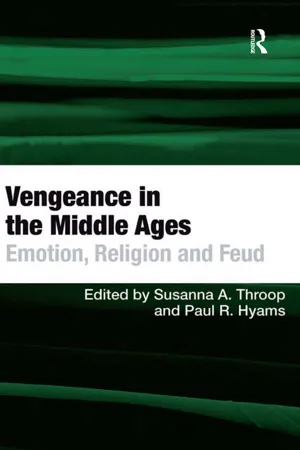
- 242 pages
- English
- ePUB (mobile friendly)
- Available on iOS & Android
About this book
This volume aims to balance the traditional literature available on medieval feuding with an exploration of other aspects of vengeance and culture in the Middle Ages. A diverse assortment of interdisciplinary essays from scholars in Europe and North America contest or enlarge traditional approaches to and interpretations of vengeance in the Middle Ages. Each essay attempts to clarify the multifaceted experience of vengeance within a specific medieval context"a particular region, a particular text, a particular social movement. By asking what relationship a distinct factor like authorship or religion has with the concept of vengeance, each author points towards the breadth of meanings of medieval vengeance, and to the heart of the deeper and broader questions that spur scholarly interest in the subject. Geographically, the essays in the volume highlight Western Europe (particularly the Anglo-Norman world), Scotland, Ireland, Spain, and Portugal. Thematically, the essays are concerned with heroic cultures of vengeance, vengeance as a legal and political tool, Christian justification and expression of vengeance, literature and the distinction between discourse and reality, and the emotions of vengeance. Methodologically, these interdisciplinary studies incorporate tools borrowed from anthropology, the study of emotion, and modern social and literary theories. This volume is aimed at professional scholars and graduate students within the broad field of medieval studies, including the subfields of history, literature, and religious studies, and is intended to inspire further research on medieval vengeance. However, this collection will also prove interesting to non-medievalists interested in the history of emotion, the justification of human conflict, and the concept of feud and its applicability to specific historical periods.
Frequently asked questions
- Essential is ideal for learners and professionals who enjoy exploring a wide range of subjects. Access the Essential Library with 800,000+ trusted titles and best-sellers across business, personal growth, and the humanities. Includes unlimited reading time and Standard Read Aloud voice.
- Complete: Perfect for advanced learners and researchers needing full, unrestricted access. Unlock 1.4M+ books across hundreds of subjects, including academic and specialized titles. The Complete Plan also includes advanced features like Premium Read Aloud and Research Assistant.
Please note we cannot support devices running on iOS 13 and Android 7 or earlier. Learn more about using the app.
Information
1 “Vengeance is Mine”: Saintly Retribution in Medieval Ireland1
Table of contents
- Cover
- Half Title
- Title Page
- Copyright Page
- Table of Contents
- Notes on Contributors
- Acknowledgements
- Introduction: The Study of Vengeance in the Middle Ages
- 1 “Vengeance is Mine”: Saintly Retribution in Medieval Ireland
- 2 The “Fyre of Ire Kyndild” in the Fifteenth-Century Scottish Marches
- 3 Living in Fear of Revenge: Religious Minorities and the Right to Bear Arms in Fifteenth-Century Portugal
- 4 Feudal War in Tenth-Century France
- 5 The Way Vengeance Comes: Rancorous Deeds and Words in the World of Orderic Vitalis
- 6 Verbal and Physical Violence in the Historie of Aurelio and Iabell
- 7 Was There Really Such a Thing as Feud in the High Middle Ages?
- 8 Zeal, Anger and Vengeance: The Emotional Rhetoric of Crusading
- Afterword: Neither Unnatural nor Wholly Negative: The Future of Medieval Vengeance
- Index